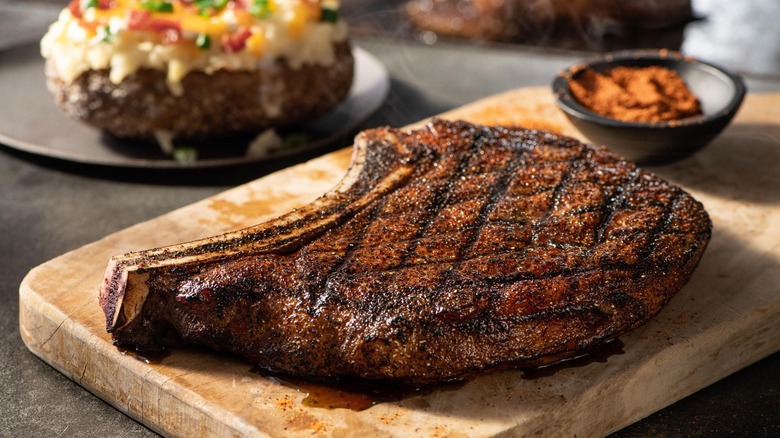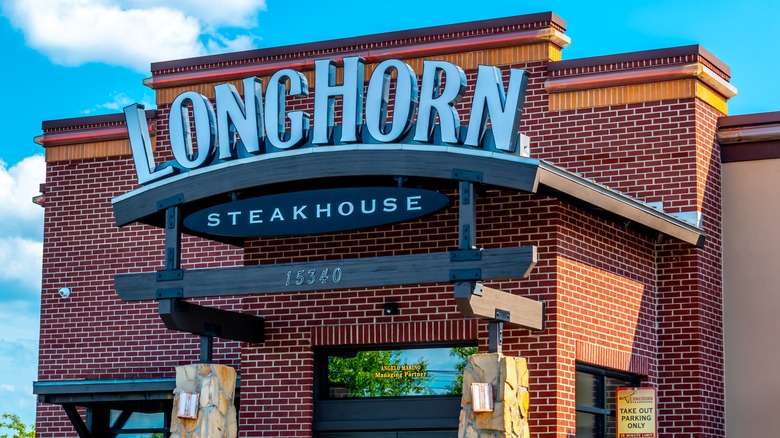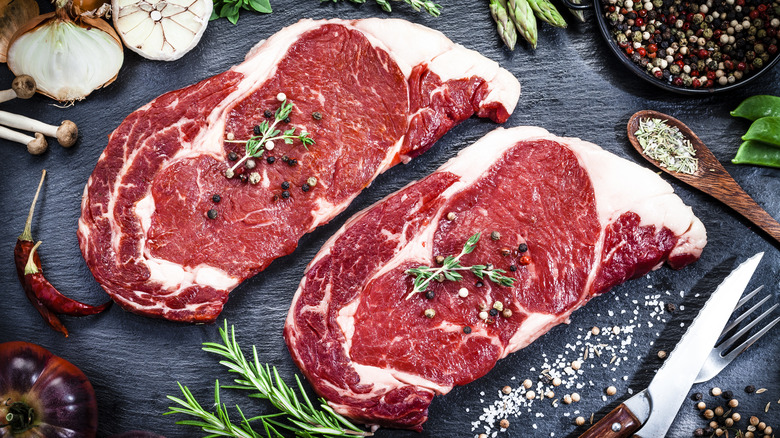Does LongHorn Steakhouse Use Frozen Or Fresh Steaks?
When you're in the mood for a nice steakhouse dinner, you might think of local chophouses or fancier chain restaurants like Ruth's Chris or Morton's The Steakhouse. The appeal of a perfectly charred piece of meat with a loaded baked potato and fresh vegetables is hard to resist. However, one drawback is the price tag. A basic cut of meat at these premium spots can cost $50 or more, without including sides. If you're not particularly interested in the upscale ambiance but still want a filling meal, LongHorn Steakhouse is worth considering.
Despite being one of the largest steakhouses in the U.S. in terms of sales, according to Statista, LongHorn takes measures to not compromise on the quality of its product. Every steak at LongHorn is delivered to the restaurant fresh and never sees the inside of a freezer. Chef Michael Senich, the executive chef for the chain, told Daily Meal that one of the steakhouse secrets that bargain brands employ in the name of saving money is to use frozen steaks. However, they just cannot compare with fresh because they are harder to cook correctly and freezing can damage the meat. Plus, with over 570 locations across the country, the chances you're near a LongHorn location are high.
A look at LongHorn's fresh steaks
One of the more notable parts about dining at LongHorn, aside from the affordability, is the wide selection of cuts. The steakhouse chain offers seven different cuts of meat, catering to various tastes and budgets. If you prefer a lean steak but still crave a juicy bite, the 6-ounce Renegade Sirloin starts at under $16 (price may vary by location). Notably, this price includes a salad and one of the chain's signature sides, such as a loaded baked potato or steamed broccoli. For those seeking a heartier option, you can upgrade to a 6-ounce filet, try a 12-ounce New York Strip, or go for the substantial 22-ounce LongHorn porterhouse, which is still a solid value at around $34.
Additionally, LongHorn treats each cut differently to enhance the flavor. The cooking method depends on whether the piece of meat has a bone. According to LongHorn, bone-in steaks are fire-grilled, while boneless cuts are seared. Moreover, all the steaks are aged for over 20 days to ensure the best possible flavor.
Are fresh steaks always better?
Now, let's address the common belief that fresh steaks are always superior to frozen ones. The truth is, it depends on the product and how long the meat has been frozen. A cut of beef from your local grocery store is generally better than a frozen one because it hasn't undergone flash-freezing. This advanced freezing process preserves the meat at its peak freshness. However, conventional freezers found in supermarkets, restaurants, and homes are not fast enough to prevent the formation of ice crystals, which can damage the meat and remove essential moisture.
Furthermore, the length of time a steak is kept frozen can affect its flavor. Frozen steak can be stored for six months to a year, but its quality will likely diminish the longer it's frozen. Additionally, Meat n' Bone emphasizes that most freezers are not cold enough to keep the meat in optimal condition. Therefore, while some steaks may benefit from being frozen, typical prime- or choice-grade cuts from most restaurants will be superior if they have never been frozen.


